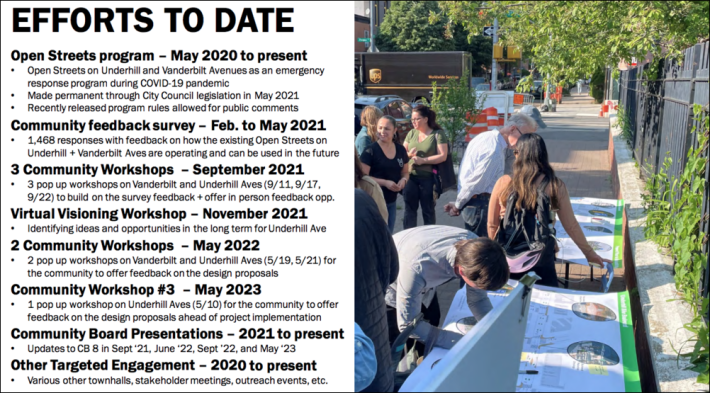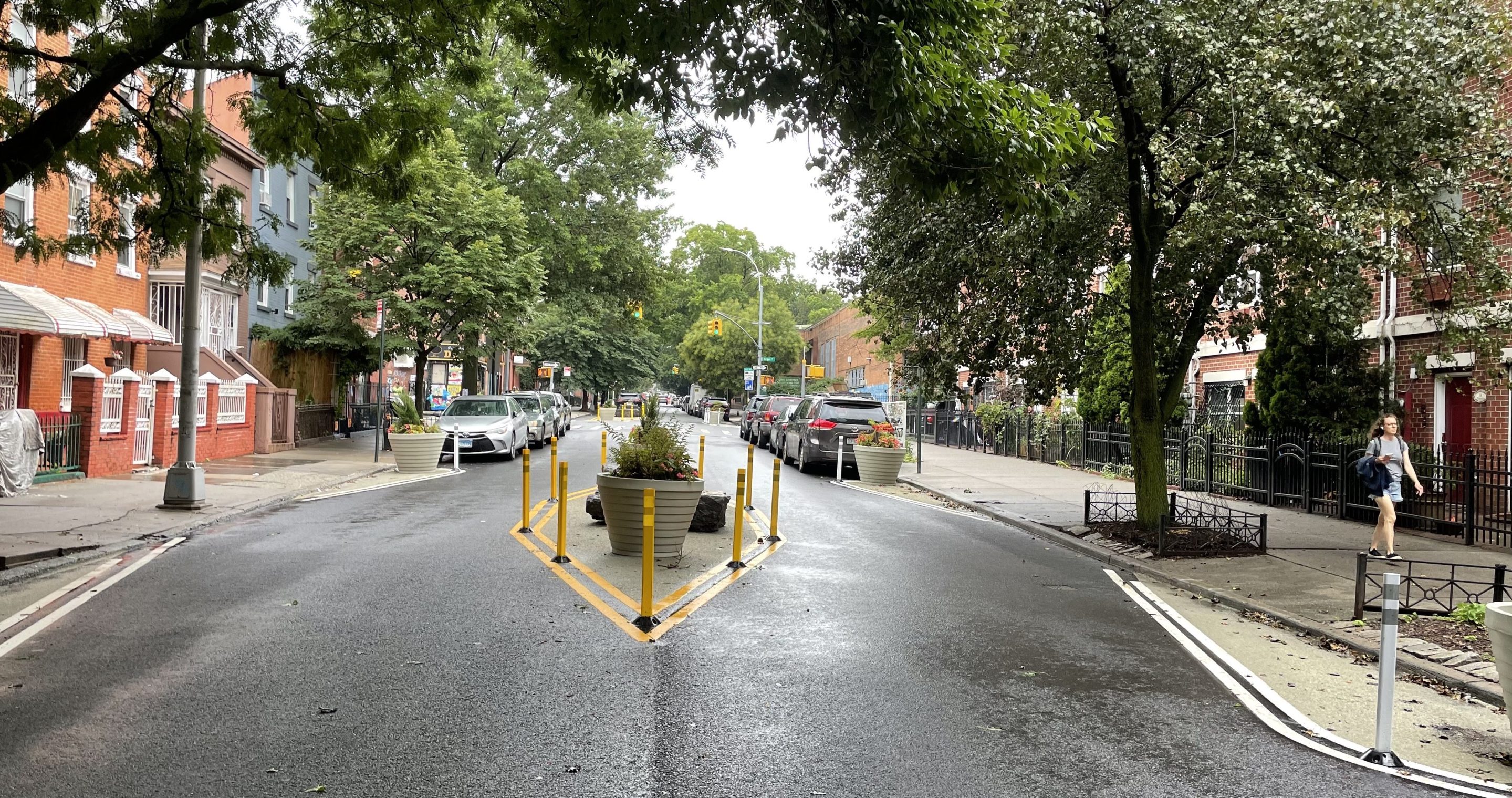The Underhill Avenue bike boulevard, a traffic-calming street redesign in Prospect Heights, has allegedly been put on hold by City Hall, and residents fear it could be the first of many local street improvements on the chopping block.
Mayor Adams told supporters of the Underhill Avenue bike boulevard that his office is reviewing the project after a small number of opponents to the nearly done project appealed to his office.
"Before it was fully complete, work stopped on Underhill," said Prospect Heights Neighborhood Development Council Executive Director Gib Veconi, who said he texted directly with the mayor. "And after communicating with the mayor, it's clear that his office is now reviewing that project in the context of this opposition."
The Department of Transportation began installing the Underhill Avenue bike boulevard late this summer and street markings and planters were almost all in place. The permanent street redesign, similar to 39th Avenue in Queens, is meant to replace the open street on Underhill, which relied on volunteers putting out barriers each day.
Beyond planters, the DOT was changing the direction of two-way Underhill to one-way southbound between Park Place and Prospect Place and between St. Marks Avenue and Bergen Street, adding painted pedestrian extensions, diamond-shaped traffic diverters that forced drivers to move slowly on the street, and contraflow bike lanes on the one-way segments. The new design would make it impossible to drive north along Underhill, but drivers could still head south all the way from Pacific Street to Eastern Parkway.

When it was originally proposed in July 2022, the bike boulevard would have prevented drivers from turning north from Eastern Parkway onto Underhill Avenue, but the final design offered a compromise, allowing two-way traffic between Eastern Parkway and Park Place. DOT said its traffic studies found that drivers seeking to get on Underhill directly from Eastern Parkway would divert to other local streets if they could not.
Adams's office disputed — albeit vaguely — Veconi's summation of his text conversation with the mayor.
"Implementation is ongoing for the Underhill redesign," said a City Hall spokesperson.
But Veconi said that in his text messages with Mayor Adams, Hizzoner told Veconi that his office was indeed reviewing the project before completion. Veconi said Adams sees himself as the mediator of neighborhood disputes like this one, even though his own DOT created what it believed was a compromise final plan. Veconi countered that the Underhill redesign was broadly popular, and was opposed by people who have been trying to remove not only the bike boulevard but a newly installed plaza at the north end of the avenue, and the Vanderbilt Avenue open street as well.
"It's a concern for us in this case, because the same people who want to see Underhill Avenue revert to through traffic are also calling for Vanderbilt Avenue to be rolled back," he said. "And so now that they apparently have an audience with the mayor, we want to make sure the mayor understands that rolling back these programs would be extremely unpopular in this neighborhood."
The reported review of the bike boulevard is the latest instance of Mayor Adams walking back street safety or transit improvements around the city. So far in 2023, Adams's office got involved to curtail and then cancel a protected bike lane and road diet on McGuinness Boulevard, prevent the completion of the Ashland Place protected bike lane and toss out a proposed offset bus lane on Fordham Road. And in 2022, Adams's office began removing the Willoughby Avenue open street before protests by area residents forced the city to keep the street treatment in place.
Stopping the McGuinness makeover, slowing down the Ashland Place treatment and removing the Willoughby open street were all reportedly tied to opposition to the projects by Ingird Lewis-Martin, a trusted Adams aide in City Hall who frequently opposes street safety designs, though it is unclear if she has had any role in delaying the Underhill Avenue project.
Recently, businesses on Washington Avenue claimed that the Vanderbilt open street was "cannibalizing" their business, but Veconi believes the Underhill Avenue review isn't related to that. A petition circulated by the open street opponents only sought "the immediate suspension of the Open Streets program on Vanderbilt and Underhill Avenues pending further review."
The petition claimed that opponents of the open street were prioritizing "the safety and well-being of our elderly and disabled residents, and the quality of life of our community as a whole." (As a matter of fact, crashes and injuries are down during open street hours when cars are largely banned.)
Vanderbilt Avenue has been one of the shining stars of the city's open streets program, persevering even as the larger citywide effort has stalled out and drawing support from thousands of visitors on weekends, as well as area businesses and volunteers who ensure the open street goes off without a hitch.
"There's really no way that we could keep a program like this going at this level for four years if it wasn't extraordinarily popular with this neighborhood and with the businesses that participate in it, and with all of the people who come from other neighborhoods to enjoy it," said Veconi. "It just couldn't happen, it defies logic to believe that something like this has gone on for four years otherwise."
History also shows that the DOT moved slowly and did substantial outreach in the area, finding support for the bike boulevard. Between 2021 and 2023, the DOT met with Brooklyn Community Board 8 four times on the subject of open streets in the Prospect Heights area. The agency also held six in-person community workshops, one virtual visioning workshop and a four-month community feedback survey to see how the neighborhood felt about the Underhill and Vanderbilt open streets.

The feedback survey overwhelmingly found people interested in permanent changes to Underhill, with 86 percent of the 1,468 respondents to the 2021 survey in favor of "permanent changes to make Prospect Heights Open Streets pedestrian and/or cycling priority corridors."
The treatments on Underhill have also worked. Between 2017 and 2019, there were 111 reported crashes on the blocks between Pacific Street and Eastern Parkway, injuring six cyclists, 13 pedestrians and 19 motorists. But between 2020 and September 2023, there have been 70 reported crashes in the same stretch, injuring five cyclists, six pedestrians and eight motorists. The work is also necessary, as shown in a recent incident on Bergen Street and Underhill Avenue where a school bus driver crashed into a parent taking two of his kids to school on a bike.
The bike boulevard reflects more recent neighborhood planning opinions, such as the vision and priorities report for the Atlantic Avenue Mixed-Use Plan in which community members asked for additional bike boulevards on Bergen Street and Dean Street. Supporting and expanding open streets is also what the mayor himself campaigned on, and Adams also just declared last week that the city was interested in creating "homes for people, not for cars" when he proposed eliminating parking minimums for new residential construction.
All of that left open street supporters in Prospect Heights scratching their heads as to why City Hall would be remotely interested in getting rid of the Underhill bike boulevard and handing opponents of the plaza and the Vanderbilt open street a victory. The Prospect Heights Neighborhood Development Corporation has launched its own petition in support of the bike boulevard, plaza and open street in the neighborhood, which has picked up over 1,500 signatures since Friday.
"We we hope that [the mayor] understands that this is a program that aligns with all of the city's stated policy goals with respect to street safety, with respect to reducing carbon emissions, with respect to economic development. They create a significant economic benefit for over 20 restaurants that participate in our Vanderbilt program, more than half of which are minority and women owned," said Veconi.






